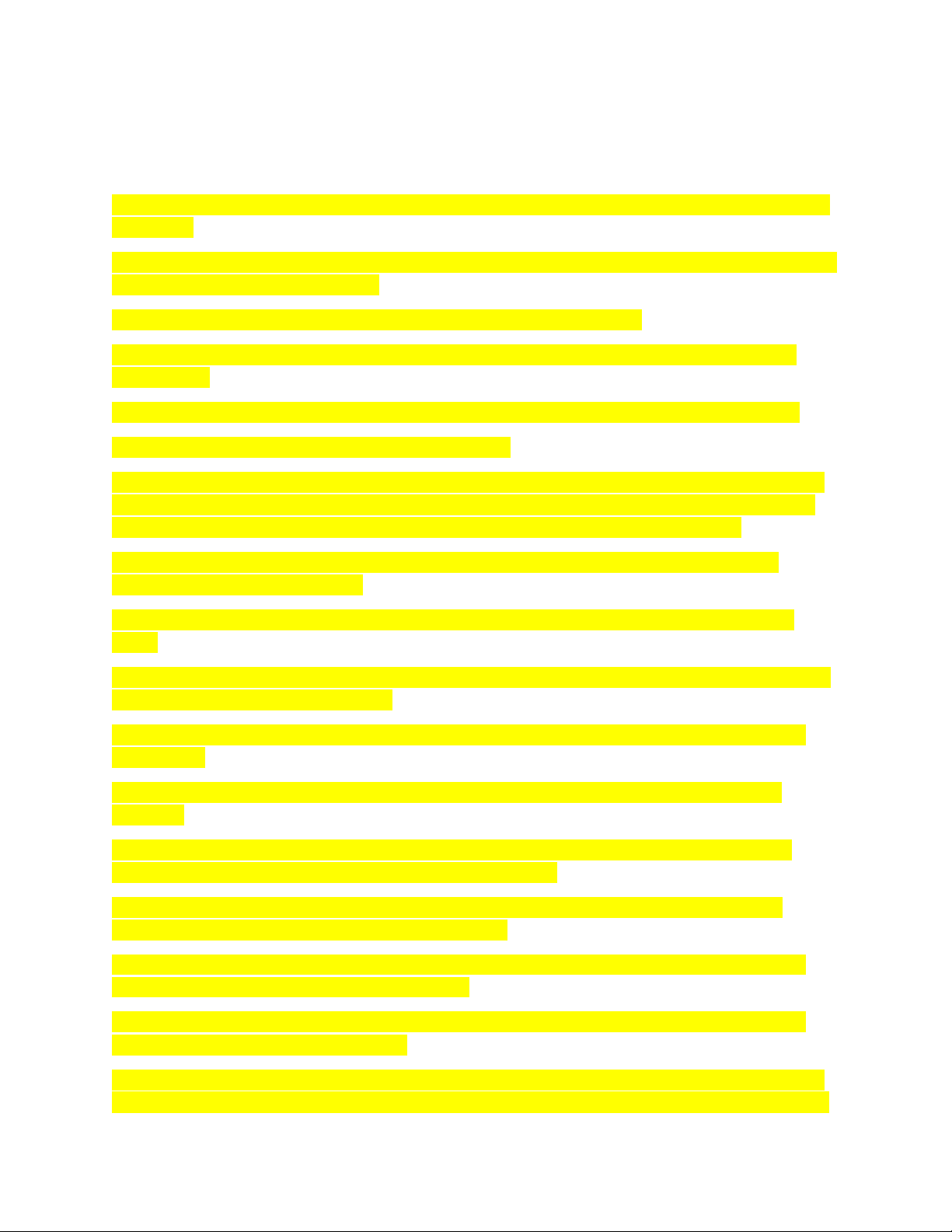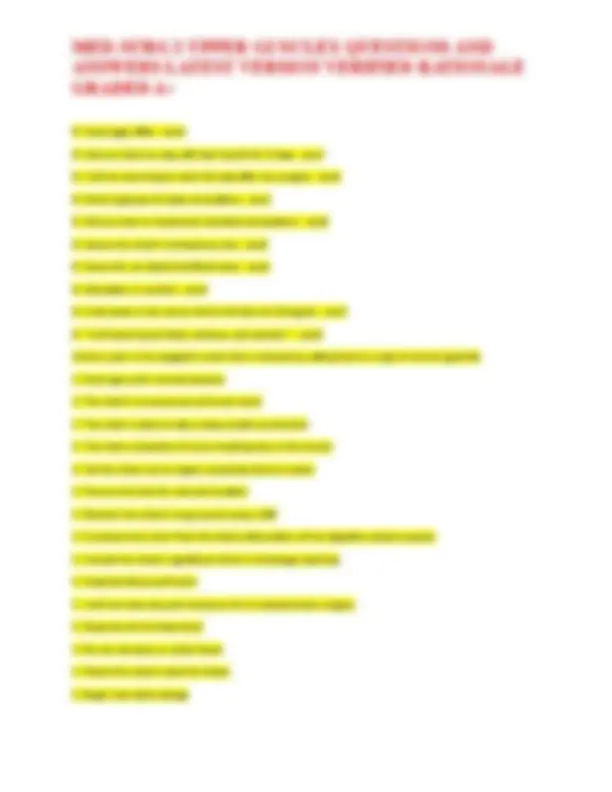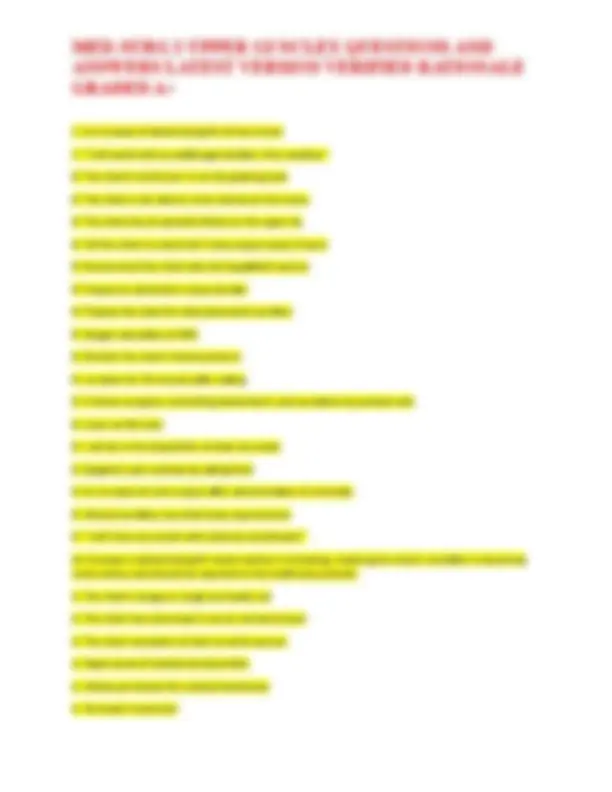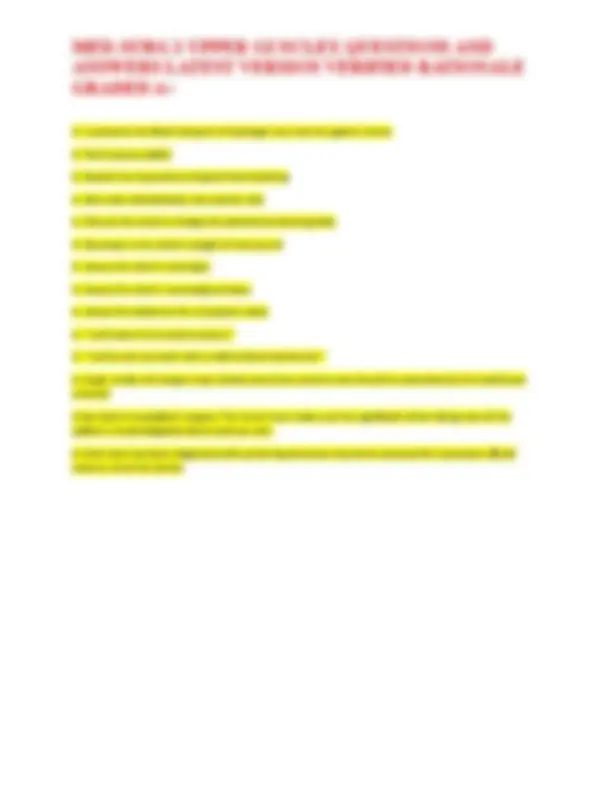





Study with the several resources on Docsity

Earn points by helping other students or get them with a premium plan


Prepare for your exams
Study with the several resources on Docsity

Earn points to download
Earn points by helping other students or get them with a premium plan
Community
Ask the community for help and clear up your study doubts
Discover the best universities in your country according to Docsity users
Free resources
Download our free guides on studying techniques, anxiety management strategies, and thesis advice from Docsity tutors
MED-SURG 2 UPPER GI NCLEX QUESTIONS AND ANSWERS LATEST VERSION 2025 VERIFIED RATIONALE GRADED A+.pdf
Typology: Exams
1 / 6

This page cannot be seen from the preview
Don't miss anything!




Which priority teaching information should the nurse discuss with the client to help prevent contracting hepatitis B? Which intervention should the nurse implement specifically for the client in end-stage liver failure who is experiencing hepatic encephalopathy? Which instruction should be discussed with the client diagnosed with GERD? Which data should the nurse report to the healthcare provider when assessing the oral cavity of an elderly client? Which complain is significant for the nurse to assess in the adolescent male who uses oral tobacco? This statement is the rationale for proton pump inhibitors The nurse should monitor the client for the first bowel movement to document elimination of barrium, which should be eliminated within two days. If the client does not have a bowel movement, a laxative may be needed to help the client eliminate the barrium before it becomes too hard to pass The nurse is caring for the client diagnosed with hepatic encephalopathy. What sign or symptom indicates the disease is progressing? The nurse is caring for an elderly client with acute gastritis. Which client problem is priority for this client? The nurse is caring for a client with ascites secondary to hepatic cirrhosis. Which information should the nurse report to the healthcare provider? The nurse is caring for a client who is one day post-upper GI series. Which assessment data warrants intervention? The nurse is assessing the client diagnosed with chronic gastritis. Which symptom(s) support this diagnosis? The nurse is assessing a client in end-stage liver failure who is diagnosed with portal hypertension. Which intervention should the nurse include in the plan of care? The nurse is administering a PPI to a client diagnosed with peptic ulcer disease. Which statement supports the rationale for administering this medication? The nurse identifies the problem of "fluid volume deficit" for a client diagnosed with gastritis. Which intervention should be included in the plan of care? The increased serum ammonia level associated with liver failure causes the hepatic encephalopathy, which, in turn, leads to neurological deficit The inability to circle menu items may indicate deterioration in the client's cognitive status. The client's neurological status is impaired with hepatic encephalopathy. The nurse should investigate this behavior.
The hepatitis B vaccine will prevent the client from contracting this disease The client should avoid spicy and acidic foods, as well as alcohol, caffeine, and tobacco, as they increase gastric secretions The client is complaining of painful swallowing, secondary to mouth ulcers. Which statement indicates the nurse's teaching has been effective? The client is being prepared for discharge after a laparoscopic cholecystectomy. Which intervention should the nurse implement? The client is admitted to the ED complaining of acute epigastric pain and reports vomiting a large amount of bright red blood at home. Which interventions should the nurse implement? List in order of priority. The client diagnosed with a hiatal hernia is scheduled for a Nissen fundoplication. Which statement indicates the nurse's teaching is effective? Presence of any non-healing sore on the lips or mouth may be oral cancer. Oral cancer risk increases by using oral tobacco. Pediatric and geriatric clients have an increased risk of fluid volume deficit. The nurse should always be alert to this possible complication Irritating substances should be avoided during outbreaks of ulcers in the mouth. Spicy foods, alcohol, and tobacco are common irritants the client should avoid In a laparoscopic Nissen fundoplication, there are 4 to 5 incisions approximately 1 inch apart allowing for the passage of equipment to visualize the abdominal organs and perform the operation Fluid administration is the medical treatment for dehydration so the nurse must monitor and ensure the IV site is patent E. Type and crossmatch for a blood transfusion - ansA, D, E, B, C D. Weigh the client twice each week - ansA D. The client's uvula rises with the mouth open - ansA D. The client is able to eat previously restricted meal items - ansB D. The client has bilateral ducts at the second molars. - ansC D. Start an IV with an 18-gauge needle D. Nausea and projectile vomiting - ansB D. It neutralizes the hydrochloric acid secreted by the stomach - ansA.
C. An increase of abdominal girth of two inches C. "I will swish with an antifungal solution, then swallow." B. The client's tonsils are +1 on the grading scale B. The client is not able to circle choices on the menu B. The client has an episodic blister on the upper lip B. Tell the client to check the T-tube output every 8 hours B. Recommend the client take the hepatitis B vaccine B. Prepare to administer a loop diuretic B. Prepare the client for total parenteral nutrition B. Oxygen saturation of 96% B. Monitor the client's blood pressure B. Lie down for 30 minutes after eating B. It blocks receptors controlling hydrochloric acid secretions by parietal cells B. Insert an NG tube B. I will be in the hospital for at least one week B. Epigastric pain relieved by eating food B. An increase of urine output after administration of a diuretic B. Altered nutrition; less than body requirements B. "I will rinse my mouth with Listerine mouthwash." An increase in abdominal girth means ascites is increasing, meaning the client's condition is becoming more serious and should be reported to the healthcare provider A. The client's tongue is rough and beefy red A. The client has a decrease in serum ammonia level A. The client complains of clear to white sputum A. Rapid onset of midsternal discomfort A. Obtain permission for a blood transfusion A. No bowel movement
A. It prevents the final transport of hydrogen ions into the gastric lumen A. Fluid volume deficit A. Explain the importance of good hand washing A. Eat a low-carbohydrate, low-sodium diet A. Discuss the need to change the abdominal dressing daily A. Decrease in the client's weight of one pound A. Assess the client's vital signs A. Assess the client's neurological status A. Assess the abdomen for a tympanic wave A. "I will have 4 to 5 small incisions." A. "I will brush my teeth with a soft-bristled toothbrush." A rough, beefy-red tongue may indicate pernicious anemia and should be evaluated by the healthcare provider A lap chole is outpatient surgery. The nurse must make sure the significant other taking care of the patient is knowledgeable about post-op care. A client who has been diagnosed with portal hypertension should be assessed for a tympanic (fluid) wave to check for ascites